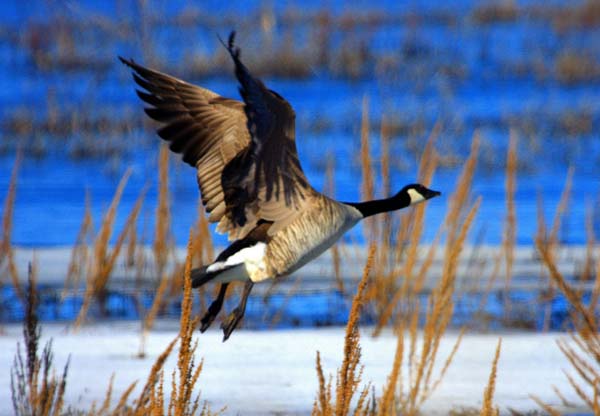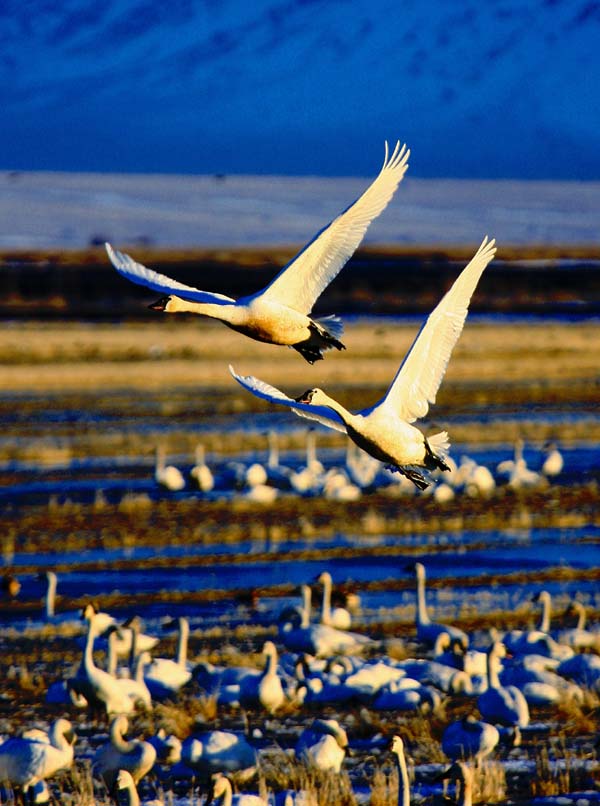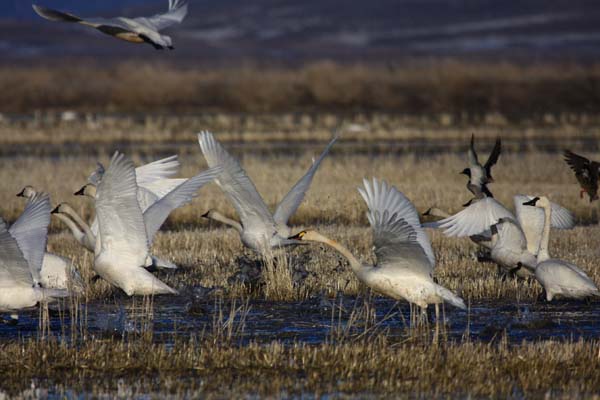Story and Photos by Larry Turner
I remember as a child the wonderment: the bright, blue, spring sky turning
dark and light with multi-patterned winged movements. A kaleidoscope of dappled
light as thousands of geese, swans and ducks passed above our Stateline Road
Malin, Oregon home.
|
Lower Klamath Wetlands
|
Lower Klamath Raptor
|
Lower Klamath Sunset
|
I marveled at the immensity of the wild scene. I still do, some 50 years later.
As the earth tilts, bringing the Northern Hemisphere back toward the Spring Equinox—singling winter’s end—waterfowl migrate back north from their more hospitable southern winter homes, stopping and funneling through Northern California and Southern Oregon’s Klamath Basin en route to Alaska and Canadian breeding grounds. Some—notably swans and bald eagles—had made the Basin their southern winter homes. They, too, join the flying chorus for the migration.
Old timers—I now included—remember the day when the migrating birds,
measured in the millions, would sometimes block out the sun above one’s
head. Countless times I had experienced such. It still happens, but it is less
so because of urban expansion and the takeover of wetlands, farmlands and ranchlands
throughout the Americas, the burgeoning human populations reducing habitat and
therefore waterfowl numbers.
 |
 |
|
|
Merganser
|
Canada Goose
|
Feasting in Farm Fields
|
The Basin—heart of the Pacific Flyway—throbs in late winter and
spring with the sweet cacophony of snow geese and other migratory birds. There’s
poetry in the air and on the land as ancestral stopovers in the Klamath Basin
are perfect for refueling. Farmers, ranchers and caretakers of the federal lands
deserve merit badges as land stewards for the migratory waterfowl. Private and
federally leased grain fields provide the bulk of the migratory bird’s
food source as they gather the leavenings from the previous autumn’s harvest.
Waterfowl droppings help enrich the fields for new plantings. On the flip side,
migratory birds—as nondiscriminatory eaters—can wreak havoc on new
alfalfa and other crop plantings. Farmers and ranchers contribution to the migrating
geese in the Basin is the greatest as they often have to replant winter grain
crops that have been devoured during the stopover. However, farmers and ranchers
take it in stride as just an aspect of their occupation.
 |
||
|
Swan Song
|
Swan Feather
|
Whistling Swans
|
I, too, feel migratory as I have lived in four different places this last year. I’m most at home here, though, under the declining winter sky, mesmerized by the sight of pure white bodied and black wing tipped snow geese forming Vs before my winter-wearied and housebound eyes. I bound cheerfully and buoyantly from the house when I hear the migratory symphony in the air.
I know that garden planting time is not far off. I know I’ll be able
to shed some layers and expose some sun-starved skin. The migratory sounds and
sights mean promise and hope. But more than anything, it is beauty solely on
its own—the magic of a moment…a time to breath deeply and exhale slowly…to
ponder perfection in nature, and the individual pursuit to live a good and purposeful
life.
|
Snow Geese Rising
|
Pintails
|
Swans and Ducks
|
LOWER KLAMATH NATIONAL WILDLIFE REFUGE
My favorite area to go and view the migration is Lower Klamath National Wildlife
Refuge. The deeper in on the dirt dike and levee roads, the better. A perfect
day would be sunshine and high clouds. Mount Shasta will be dressed in a pure
white gown with fringes of dark exposures from the high talus steeps. There
will be large patches of snow dispersed with brown, open ground on the Basin
floor. A patchwork of white, brown and hues of golden autumn remnants. Green
has not yet arrived.
|
Golden Eagle
|
Mount Shasta
|
Golden Eagle
|
Lower Klamath was established in 1908 under the Theodore Roosevelt administration,
the nation’s first waterfowl refuge. It encompasses 54,000 acres of marshlands,
croplands, drain ditches and canals, open water and uplands. Marsh represents
30,000 acres, croplands15, 000 and uplands 9,000. The refuge is a winter haven
for the American bald eagle, representing the largest populations in the lower
48 states during this season. In autumn and spring, robust populations of migratory
birds make extended stopovers for rest and food. Summer months find active breeding
and nesting populations of a variety of birds, such as the white pelicans, egrets,
blue herons, white-faced ibis, yellow-headed blackbirds, terns, tri-colored
blackbirds, Canada geese, raptors, eagles, shorebirds and ducks. Deer, raccoons,
river otters and coyotes exist here, too, as does an occasional mountain lion
and bobcats.
|
Lower Klamath National Wildlife Refuge
|
Heart of the Pacific Flyway
|
Lower Klamath Afternoon
|
Lower Klamath has short and long tour routes, including blinds for photography. Along Township Road in Oregon (off Highway 97) and Stateline Roads (along the Oregon-California border) there’s an abundance of snow geese, white-fronted geese, Ross’ geese, whistling swans, ducks (including pintails, gadwalls, canvasbacks, mallards) tundra swans and other wild birds. Tulelake National Wildlife Refuge—less than ten miles away-- is equally abundant with migratory waterfowl. If not marked closed to the public, it behooves one to explore the off tour roads by vehicle or foot.
Traveling some of these back roads reminds me of past journeys to the Yukon
Territory and Alaska. There is wildness in the air and on the ground. The only
difference is: I’m only fifteen miles from home.
|
Evening Flight
|
Bald Eagle
|
Mount Dome
|
ADDITIONAL INFORMATION: Lower Klamath National Wildlife Refuge and Tulelake National Wildlife Refuge can be accessed from Klamath Falls via either Highway 97 (take Township, Lower Lake or Stateline Roads) or Highway 139(through Merrill, Oregon or Tulelake, California). What to bring: binoculars, camera, all-weather gear, good sturdy boots, bird identification book, sack lunch (extras are available in Merrill and Tulelake stores), chairs and a portable table for a more relaxing lunch while viewing waterfowl (especially if the sun is out). Where to stay: Ellis Motel (Tulelake, 530-667-5242), Merrill Motel (541-798-5598), Running Y Ranch Resort (Klamath Falls, Oregon; runningy.com).
Prints may be purchased by contacting Larry at Skiturn789@yahoo.com.